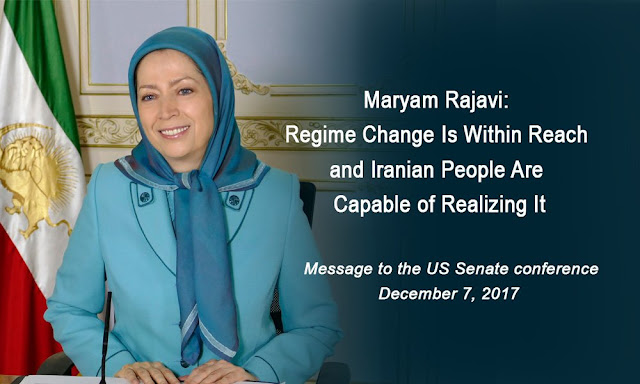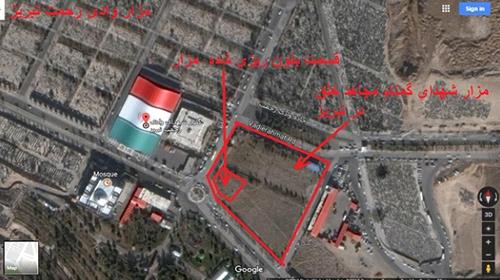According to Mohammad Mohaddesssin, chairman of the NCRI’s foreign affairs committee and a veteran PMOI (MEK) official:
“From the start of the revolution we tried to have the regime reform. While Khomeini and other groups claimed that Iran’s main enemy after revolution was the US, we said the main threat and enemy to freedom is not the West; rather it is from religious fundamentalist forces in Iran who are gradually curbing all liberties. We tried to back liberal elements in the regime to weaken the hard-liners. Many of our sympathizers were arrested or killed during this period.
“June 20, 1981 marked the end of the regime’s toleration and any possible potential for reforms, and it has not changed since. The last reformist elements were eliminated from within the regime were purged at that stage. Since that day any Iranian or foreigner who has sought to find reformist elements in this regime has been searching for a mirage. We said this from the onset. The velayat-e-faqih regime is incapable of reform. If it were to halt the persecutions, tortures and executions for even one day and announce to the Iranian people that they would face no repercussions for their actions on that day, undoubtedly the people would topple the regime on that very day.”
This passage from the book ‘Democracy Betrayed’, published by the NCRI’s Foreign Affairs Committee offers a more in-depth understanding of the events leading to the beginning of the Resistance:
“Immediately after Khomeini seized power, a fundamental dispute surfaced between the Mojahedin [PMOI/MEK] and the clerical regime. Massoud Rajavi publicly named freedom as the Iranian people’s principal demand in the revolution which had toppled the shah. His remarks launched a nationwide campaign by the Mojahedin [PMOI/MEK] to defend democracy. From the outset, the regime organized hoodlums – the forerunners of the hezbollah – to heckle and harass Mojahedin [PMOI/MEK] supporters, and disrupt peaceful political activities. Not a day went by without attacks somewhere in the country on their gatherings and those of other current Council members, such as the National Democratic Front.
In January 1980, Khomeini issued a fatwa, vetoing Massoud Rajavi’s candidacy for the presidency. The French daily, Le Monde, [on March 29, 1980] wrote:
… According to diverse estimates, had Imam Khomeini not vetoed his candidacy in the presidential election last January, Mr. Rajavi, would have gotten several million votes. He was, moreover, assured of the support of the religious and ethnic minorities – whose rights to equality and autonomy he defended – and a good part of the female vote, who seek emancipation, and the young, who totally reject the “reactionary clergy”… The Mojahedin [PMOI/MEK] have not ceased denouncing, documenting and issuing calls about “the irregularities, pressures, fraud and violence” surrounding the first round of elections. 2,500 of their supporters were wounded, 50 of them gravely, by armed bands of “Hezbollah” in the course of the election campaign… Observers appointed by the Mojahedin [PMOI/MEK] who protested the election fraud were expelled from the premises, beaten, and sometimes arrested…
Another round of attacks on Mojahedin [PMOI/MEK] offices and gatherings followed, in which many of their supporters were killed or injured. In June 1980, Le Monde wrote:
… The objective of the popular gathering on Thursday afternoon, called by the People’s Mojahedin Organization of Iran [PMOI/MEK], was to protest against attacks on their supporters and activists in the past few days…
Tens of thousands of the party’s sympathizers had lined up at the entrance gates an hour before the gathering [at Amjadieh Stadium] when groups of Hezbollah began loudly protesting against the PMOI (MEK)… chanting, “There is only one party, the Party of God, and only one Leader, Imam Khomeini.”
The Hezbollah claims no precise political organization. They are notorious among the public as the shock troops… and serve as the tool of the extreme right faction of the Islamic Republic Party, directed by [Mohammad] Beheshti… The Hezbollah tried to prevent the gathering from taking place… They attacked the entrances to the stadium… The police and Revolutionary Guards for once observed strict neutrality. They did not turn their forces on the attackers, but they did protect them from the PMOI (MEK) 10 to 20 times more numerous… Things as they stand, the choice, according to observers, is between conciliation and civil war. [June 14, 1980]
Lines Are Drawn
“Our enemy is neither in the United States, nor the Soviet Union, nor Kurdistan, but right here, right under our nose, in Tehran.”
With these words, in late June 1980 Khomeini drew the lines. “Death to the Mojahedin [PMOI/MEK]” became the regime’s motto and Hezbollah stepped up its attacks on the organization’s centers, all legal. Two weeks prior, on June 12, 1980, in the famous speech, “What’s to be done?” at Tehran’s Amjadieh stadium, Massoud Rajavi had exhorted the crowd of 200,000 gathered in and out of the stadium, to “defend freedoms… freedom of speech, associations and gatherings.” The nonviolent resistance of thousands of Mojahedin [PMOI/MEK] supporters effectively frustrated the Pasdaran effort to disrupt the meeting with tear gas and live ammunition. Their assault left one dead, hundreds wounded and thousands beaten up, arousing the public’s sympathy for the Mojahedin [PMOI/MEK] and disdain for the regime’s crime. Even Khomeini’s son, Ahmad, condemned the Revolutionary Guards’ action as “treachery to Islam.” The Police Chief, Deputy Interior Minister and a number of Majlis deputies condemned the attack. A flood of letters and telegrams of condemnation from different political organizations, various sectors of society, and members of the business community were reprinted in the media, greatly alarming Khomeini. He had to make a choice: Either back down, or step up the political onslaught on the Mojahedin [PMOI/MEK]. A week later, the Mojahedin [PMOI/MEK] revealed a tape recording of a speech by Hassan Ayat, one of the leaders of the ruling party, in which he revealed the details of the plots. Khomeini hedged no longer, and on June 25, 1980, pointed his finger at enemy number one. The Mojahedin [PMOI/MEK], he said, “are worse than infidels.”
Even the organization’s health clinics soon came under attack. There were more deaths and injuries, and thousands of arrests. Responding to a letter of complaint by Mojahedin [PMOI/MEK] supporters in August 1980, when the organization still engaged in public activities, Mullah Allameh, head of the revolutionary court of Bam, in southern Iran, wrote: “According to the decree of Imam Khomeini, the Mojahedin [PMOI/MEK] of Iran are infidels and worse than blasphemers… They have no right to life.”
Mohammad Yazdi, head of the regime’s Judiciary, referred to Khomeini’s order to massacre the Mojahedin [PMOI/MEK] and their supporters, issued months before it became public, as follows:
The Imam’s hand-written judicial order condemned the Mojahedin [PMOI/MEK] – the totality of the organization and its infrastructure, and not individuals – so that there would be no hesitation in terming the activities by these individuals as waging war on God and corruption on Earth [and carrying out their execution orders].
Referring to the events of 1979-81, the [US] State Department acknowledges these facts in its December 1984 report:
The Mujahedin [PMOI/MEK] have never accepted the Khomeini regime as an adequate Islamic government. When Khomeini took power, the Mujahedin [PMOI/MEK] called for continued revolution, but said they would work for change within the legal framework of the new regime. The Mujahedin publications emphasized their unique role as an urban guerrilla force that promised to enter candidates for the highest offices under the new political system. The Mojahedin [PMOI/MEK] also entered avidly into the national debate on the structure of the new Islamic regime. The Mujahedin [PMOI/MEK] unsuccessfully sought a freely elected constituent assembly to draft a constitution.
The Mujahedin [PMOI/MEK] similarly made an attempt at political participation when Mujahedin [PMOI/MEK] leader Masoud Rajavi ran for the presidency in January 1980. Rajavi was forced to withdraw when Ayatollah Khomeini ruled that only candidates who had supported the constitution in the December referendum – which the Mojahedin [PMOI/MEK] had boycotted- were eligible. Rajavi’s withdrawal statement emphasized the group’s efforts to conform to election regulations and reiterated the Mojahedin [PMOI/MEK]’s intention to advance its political aims within the new legal system.
In March and May 1980, Rajavi and several other Mujahedin [PMOI/MEK] ran in Tehran for the Islamic Assembly (Majlis). Moussa Khiabani, Rajavi’s deputy, ran in Tabriz, and others ran in the north, where the group was strong. The Mujahedin [PMOI/MEK] attempted to demonstrate their broadened appeal by running on their ticket several moderate political figures…
Between the two election rounds, the Mujahedin [PMOI/MEK] announced that its members would disarm to prove that they were not initiating the clashes with the fundamentalists that had become endemic during the campaign. The fundamentalists responded by once again banning Mujahedin representatives from the university campuses. The group’s allegations that vote tallies had been altered to deny Rajavi and Khiabani victories, were ignored.
Rajavi then began to hint that the Mujahedin [PMOI/MEK] were considering active opposition to the Khomeini regime. In the early summer of 1980 the Mujahedin [PMOI/MEK] staged several rallies in Tehran drawing up to 150,000 people to hear Rajavi promise to carry on the opposition to fundamentalist domination.
On June 25 Khomeini responded by a major statement against the Mujahedin [PMOI/MEK], claiming their activities would derail the revolution and bring back “US dominance.”
For a year after Khomeini’s remarks, the Mojahedin [PMOI/MEK] continued to work for democracy through peaceful political means. This era ended on June 20, 1981, when heavily armed Guards turned a peaceful demonstration called in Tehran by the Mojahedin into a blood bath.
Thousands of Iranian women gave their lives for freedom
 June 20 marks the beginning of the Iranian people's resistance for freedom and democracy in 1981. Iran’s women pioneer their people's movement against the mullahs' religious dictatorship.
June 20 marks the beginning of the Iranian people's resistance for freedom and democracy in 1981. Iran’s women pioneer their people's movement against the mullahs' religious dictatorship.So, let us commemorate on this anniversary the tens of thousands of women who watered the sapling of freedom with their blood and persisted on their democratic demands since the beginning of the mullahs' rule in Iran. They chose to honorably resist at any cost but not succumb to the dictator and turned into shining stars who lit the dark night of their nation.
READ MORE
A letter by Sholeh Pakravan
June 20, 1981, was a turning point in the history of the struggle of the people of Iran in their quest for freedom
Today, we are remembering political prisoners, both those who were killed in the past decades and those who are presently in prison.
Back on June 20, 1981, I was a teenager.
It was the day they opened fire on our people's demonstration.
Afterwards, only the names of young boys and girls who had been executed were announced in the newspapers.
The day turned into a turning point in the history of our people's quest for freedom...
Those days I didn't understand anything.
I didn't know the meaning of getting arrested and executed.
Arrest and execution were just two words for me and I didn't comprehend the extent of suffering hidden in just those two words.
READ MORE


















































